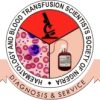doi.org/10.59708/ajlhts.v2i4.2337
Download PDF - 59 Downloads
Duffy Red Cell Antigen Phenotype among Indigenous Pregnant Women attending Antenatal Clinic at Federal Teaching Hospital Gombe, Nigeria.
Ahmed M. Gaji, Ann Ogbenna, Ahmed I. Girei, Kasim M. Pindiga, Sani Adamu, Saleh Yuguda, Ademola Adewoyin , Davies N.O.
1Department of Haematology and Blood Transfusion, College of Medicine, University of Lagos,Nigeria
2Department of Haematology and Blood Transfusion Federal Teaching Hospital Gombe, Gombe State, Nigeria.
3Department of Chemical Pathology, Federal Teaching Hospital Gombe, Gombe State, Nigeria.
Curresponding Author: mohammedgaji2@gmail.com
Abstract
Background and Objectives: Duffy (FY) blood group system is implicated in transfusion incompatibilities and haemolytic disease of the foetus and newborn. The primary objective was to determine the Duffy phenotype among the indigenous pregnant women in Gombe, Gombe State, Nigeria.
Materials and Methods: This was a cross sectional study where simple random sampling was employed on consented participants. Two hundred and fifty nine pregnant women attending antenatal clinic at Federal Teaching Hospital Gombe were randomly recruited into the study. Three milliliters (3mls) of blood was taken, and Duffy antigens typed by standard tube technique (LORNE LABORATORY UK).
Results: Among the Indigenous tribe, the percentage of Fy(a+b+) was seen in 2.2% of Fulani and 3.4% of Tangale, Fy(a+b-) phenotype was seen in 4.3% of Tangale, 6.8% of Fulani,9.5% of Tera, 10.3% of Hausa and 10.5% of Waja. Fy(a-b+) phenotype was seen in 5.3% of Waja, 7.6% of Fulani,8.7% of Tangale, 9.5% of Tera and 12.5% of Bolawa. Fy(a-b-) phenotype was seen in 2.4% of Tula,6.4% of Bolawa,7.3% of Waja, 7.8% of Tera, 17.8% of Tangale, 11.8% of Hausa and 46.5% of Fulani. 84.6% of the study population had the null Duffy phenotype.
Conclusion: The research showed the phenotypic distribution of Duffy blood group among the study participants with relatively high percentage of null Duffy phenotype hence possible risk of alloimmunisation.
Key words: Duffy phenotype, Haemolytic disease of foetus and newborn, plasmodiasis.

